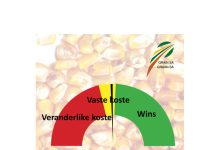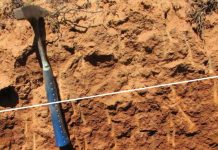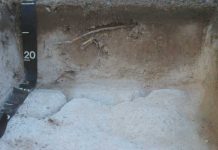



Scientific name: Tribulus terrestris
Afrikaans names: Dubbeltjie, platdubbeltjie, volstruisdoring
English name: Devil’s thorn, common dubbeltjie, burnut
Short description
Devil’s thorn is a pesky, annual endemic, creeping, prostrate weed that can spread up to 1 m in diameter.
The weed is multi-branched, with sturdy, long taproots. Stems are finely corrugate, greenish-brown and white felty haired. Leaves are opposite, once pinnately compound, with one of the pair shorter than the other.
The upper (adaxial) surface of the leaves is bright shiny green, the lower (abaxial) surface is dull green to white because of dense hairs. Flowers are axillary, solitary, bright yellow, on hairy pedicels and are up to 1 cm in diameter.
Young fruits in which seeds are borne, are green, fleshy but become woody, each with two long and two shorter, sharp spines. Seed fruits’ spines are very sharp and hook onto animals’ wool, coat and feet, as well as onto shoe soles and tractor tyres. This is how they are distributed.
Devil’s thorn only propagate by means of seed. The plant causes “geeldikkop” disease or tribulosis in sheep, especially when wilted plants are eaten (hot, dry conditions).
Distribution
Widespread in southern Africa. They are a problem on sandy soils, especially in parts of the North West Province and can be a strong competitor for moisture. Devil’s thorn seeds have the ability to still emerge and grow successfully, even in very dry conditions.
Control
Cultivation
Because of its prominent tap roots, devil’s thorn can be easily controlled mechanically by severing its tap roots beneath the soil.
Chemical
Control with pre-emergence herbicides is precarious where devil’s thorn is a serious problem (high levels of infestation). Enough soil moisture is necessary to activate the pre-emergence herbicides in the soil and to give effective control.
Post-emergence herbicides gives better control, but then devil’s thorn has to be controlled as early as possible – before it reaches the six leaf stadium. Because it is a prostrate and creepy weed, it has to be controlled before it branches. The control of bigger devil’s thorn will be less successful. Herbicides registered for the control of devil’s thorn in maize and wheat are summarised in Tables 1 and Table 2.
TABLE 1: Herbicides registered on maize for the control of Devil’s thorn.
| Active ingredient | Formula | Time of application |
|---|---|---|
| 2,4-D | 480 g/litre | Only post-emergence when crop is 30 cm tall, drop-arms should be used for directed application |
| 2,4-D/dicamba | 240/80 g/litre | Post-emergence when weed is actively growing, five to six leaf stage |
| acetochlor/atrazine/simazine | 160/165/165 g/litre | Pre-emergence or just after planting |
| acetochlor/atrazine/terbuthylazine | 125/187,5/87,5 g/litre | Pre-emergence with plant or within three days after planting |
| acetochlor/atrazine/terbuthylazine (with and without safener) | 150/225/225 g/litre 200/150/150 g/litre 250/225/225 g/litre 350/175/175 g/litre | Early post-emergence, but not later than the four leaf stage of the weed |
| atrazine | 500 g/litre | Pre-emergence on well-prepared seedbed. Early post-emergence at two leaf stage of the weed |
| atrazine/cyanazine | 167/333 g/litre 250/250 g/litre | Pre-emergence or early post-emergence |
| atrazine/mesotrione/s-metolachlor | 208,5/26,8/208,5 g/litre | Pre-emergence |
| atrazine/metazachlor/terbuthylazine | 210/60/210 g/litre | Pre-emergence or within three days after planting. Can be followed-up with an early post-emergence application |
| atrazine/sulcotrione | 300/125 g/litre | Pre- or post-emergence application |
| atrazine/terbuthylazine | 250/250 g/litre 300/300 g/litre 450/450 g/kg | Pre-emergence or post-emergence, but before four leaf stage of weed |
| atrazine/terbutryn | 250/250 g/litre | Pre-emergence with planting or just after planting |
| bendioxide | 480 g/litre | Post-emergence application |
| bromoxynil | 225 g/litre 400 g/litre 450 g/litre 500 g/litre | Post-emergence application when weed is still between the four to six leaf stage |
| bromoxynil/terbuthylazine | 150/333 g/litre | Post-emergence application |
| dicamba | 700 g/kg | Post-emergence application before crop is 30 cm tall |
| dicamba/topramezone | 160/50 g/litre | Early post-emergence before the six leaf stage. Apply with tank mix of atrazine or atrazine/terbuthylazine |
| flumetsulam | 200 g/litre 800 g/kg | Pre-emergence, apply with tank mix of metolachlor or s-metolachlor |
| glyphosate/mesotrione/s-metolachlor | 250/25/250 g/litre | Post-emergence, only on glyphosate-resistant cultivars |
| halosulfuron | 750 g/kg | Post-emergence application |
| MCPA | 400 g/litre 700 g/kg | Pre-emergence application within five to six days of planting Post-emergence until crop is 30 cm tall |
| mesotrione | 480 g/litre | Pre- or post-emergence. Apply only in tank mix with atrazine, terbuthylazine or s-metolachlor |
| s-metolachlor | 960 g/litre | Pre-emergence application within three days after planting |
| s-metolachlor/terbuthylazine | 102,8/497,2 g/litre 312,5/187,5 g/litre | Pre-emergence application Early post-emergence application with tank mix of mesotrione |
| metribuzin | 480 g/litre | Post-emergence application between four and six leaf stage of weed in tank mix with 2,4-D or bromoxynil |
| nicosulfuron | 240 g/litre 40 g/litre 750 g/kg | Post-emergence application between two and six leaf stage of crop |
| tembotrione/isoxadifen-ethyl | 420/120 g/litre | Post-emergence application in tank mix with atrazine |
| topramezone/dicamba | 50/160 g/litre | Early post-emergence before six leaf stage apply in tank mix with atrazine or atrazine/terbuthylazine |
TABLE 2: Herbicides registered on wheat for the control of Devil’s thorn.
| Active ingredient | Formula | Time of application |
|---|---|---|
| 2,4-D | 480 g/litre | Post-emergence application when crop is between seven and 13 growth stage |
| 2,4-D/dicamba | 240/80 g/litre | Post-emergence application when crop is between seven and 13 growth stage |
| bendioxide | 480 g/litre | Post-emergence application when weed is still actively growing |
| bromoxynil | 225 g/litre 400 g/litre 450 g/litre 500 g/litre | Post-emergence application before the six leaf stage of the weed and the three leaf stage and the end of stooling stage |
| chlorsulfuron | 750 g/kg | Post-emergence application when crop is between two and five leaf stage |
| chlorsulfuron/metsulfuron-methyl/ tribenuron-methyl | 119/79/222 g/kg | Post-emergence application when crop is between four and six leaf stage |
| dicamba | 700 g/kg | Post-emergence application in tank mix with Enhancer (10 - 12 g) and Reaper (10 g) |
| halosulfuron | 750 g/kg | Post-emergence application |
| MCPA | 400 g/litre 700 g/kg | Post-emergence application when crop is between seven and 13 growth stage |
| metsulfuron-methyl | 200 g/kg 600 g/kg | Post-emergence when crop is between three to five leaf growth stage |
| metsulfuron- methyl/thifensulfuron | 68/680 g/kg | Post-emergence application before five leaf stage of weed |
| trifluralin | 480 g/litre | Apply before planting |
For effective control, post-emergence herbicides have to be mixed with an additive that improves the penetration of the herbicide. See product labels for specifications and tank mixtures that are registered. Always contact a reliable chemical advisor before using any chemicals to adhere to the correct dosages and specifications on the label.
Contact the writers at elbe.hugo@syngenta.com (Elbe Hugo) and deweth@arc.agric.za (Hestia Nienaber).

















